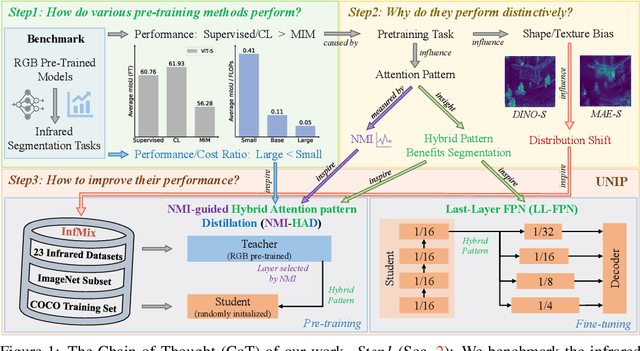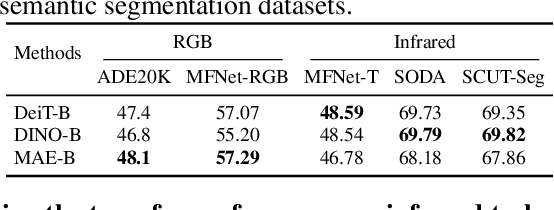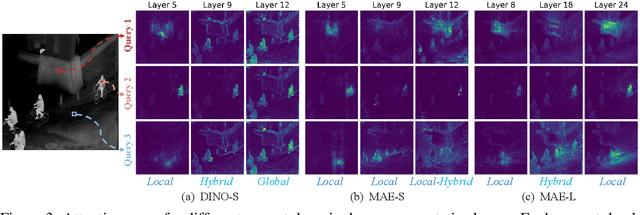Shiming Xiang
R-4B: Incentivizing General-Purpose Auto-Thinking Capability in MLLMs via Bi-Mode Annealing and Reinforce Learning
Aug 28, 2025Abstract:Multimodal Large Language Models (MLLMs) equipped with step-by-step thinking capabilities have demonstrated remarkable performance on complex reasoning problems. However, this thinking process is redundant for simple problems solvable without complex reasoning. To address this inefficiency, we propose R-4B, an auto-thinking MLLM, which can adaptively decide when to think based on problem complexity. The central idea of R-4B is to empower the model with both thinking and non-thinking capabilities using bi-mode annealing, and apply Bi-mode Policy Optimization~(BPO) to improve the model's accuracy in determining whether to activate the thinking process. Specifically, we first train the model on a carefully curated dataset spanning various topics, which contains samples from both thinking and non-thinking modes. Then it undergoes a second phase of training under an improved GRPO framework, where the policy model is forced to generate responses from both modes for each input query. Experimental results show that R-4B achieves state-of-the-art performance across 25 challenging benchmarks. It outperforms Qwen2.5-VL-7B in most tasks and achieves performance comparable to larger models such as Kimi-VL-A3B-Thinking-2506 (16B) on reasoning-intensive benchmarks with lower computational cost.
MeteorPred: A Meteorological Multimodal Large Model and Dataset for Severe Weather Event Prediction
Aug 09, 2025Abstract:Timely and accurate severe weather warnings are critical for disaster mitigation. However, current forecasting systems remain heavily reliant on manual expert interpretation, introducing subjectivity and significant operational burdens. With the rapid development of AI technologies, the end-to-end "AI weather station" is gradually emerging as a new trend in predicting severe weather events. Three core challenges impede the development of end-to-end AI severe weather system: (1) scarcity of severe weather event samples; (2) imperfect alignment between high-dimensional meteorological data and textual warnings; (3) existing multimodal language models are unable to handle high-dimensional meteorological data and struggle to fully capture the complex dependencies across temporal sequences, vertical pressure levels, and spatial dimensions. To address these challenges, we introduce MP-Bench, the first large-scale temporal multimodal dataset for severe weather events prediction, comprising 421,363 pairs of raw multi-year meteorological data and corresponding text caption, covering a wide range of severe weather scenarios across China. On top of this dataset, we develop a meteorology multimodal large model (MMLM) that directly ingests 4D meteorological inputs. In addition, it is designed to accommodate the unique characteristics of 4D meteorological data flow, incorporating three plug-and-play adaptive fusion modules that enable dynamic feature extraction and integration across temporal sequences, vertical pressure layers, and spatial dimensions. Extensive experiments on MP-Bench demonstrate that MMLM performs exceptionally well across multiple tasks, highlighting its effectiveness in severe weather understanding and marking a key step toward realizing automated, AI-driven weather forecasting systems. Our source code and dataset will be made publicly available.
Re-ranking Reasoning Context with Tree Search Makes Large Vision-Language Models Stronger
Jun 09, 2025Abstract:Recent advancements in Large Vision Language Models (LVLMs) have significantly improved performance in Visual Question Answering (VQA) tasks through multimodal Retrieval-Augmented Generation (RAG). However, existing methods still face challenges, such as the scarcity of knowledge with reasoning examples and erratic responses from retrieved knowledge. To address these issues, in this study, we propose a multimodal RAG framework, termed RCTS, which enhances LVLMs by constructing a Reasoning Context-enriched knowledge base and a Tree Search re-ranking method. Specifically, we introduce a self-consistent evaluation mechanism to enrich the knowledge base with intrinsic reasoning patterns. We further propose a Monte Carlo Tree Search with Heuristic Rewards (MCTS-HR) to prioritize the most relevant examples. This ensures that LVLMs can leverage high-quality contextual reasoning for better and more consistent responses. Extensive experiments demonstrate that our framework achieves state-of-the-art performance on multiple VQA datasets, significantly outperforming In-Context Learning (ICL) and Vanilla-RAG methods. It highlights the effectiveness of our knowledge base and re-ranking method in improving LVLMs. Our code is available at https://github.com/yannqi/RCTS-RAG.
Faster and Better LLMs via Latency-Aware Test-Time Scaling
May 26, 2025Abstract:Test-Time Scaling (TTS) has proven effective in improving the performance of Large Language Models (LLMs) during inference. However, existing research has overlooked the efficiency of TTS from a latency-sensitive perspective. Through a latency-aware evaluation of representative TTS methods, we demonstrate that a compute-optimal TTS does not always result in the lowest latency in scenarios where latency is critical. To address this gap and achieve latency-optimal TTS, we propose two key approaches by optimizing the concurrency configurations: (1) branch-wise parallelism, which leverages multiple concurrent inference branches, and (2) sequence-wise parallelism, enabled by speculative decoding. By integrating these two approaches and allocating computational resources properly to each, our latency-optimal TTS enables a 32B model to reach 82.3% accuracy on MATH-500 within 1 minute and a smaller 3B model to achieve 72.4% within 10 seconds. Our work emphasizes the importance of latency-aware TTS and demonstrates its ability to deliver both speed and accuracy in latency-sensitive scenarios.
Vision Mamba in Remote Sensing: A Comprehensive Survey of Techniques, Applications and Outlook
May 01, 2025Abstract:Deep learning has profoundly transformed remote sensing, yet prevailing architectures like Convolutional Neural Networks (CNNs) and Vision Transformers (ViTs) remain constrained by critical trade-offs: CNNs suffer from limited receptive fields, while ViTs grapple with quadratic computational complexity, hindering their scalability for high-resolution remote sensing data. State Space Models (SSMs), particularly the recently proposed Mamba architecture, have emerged as a paradigm-shifting solution, combining linear computational scaling with global context modeling. This survey presents a comprehensive review of Mamba-based methodologies in remote sensing, systematically analyzing about 120 studies to construct a holistic taxonomy of innovations and applications. Our contributions are structured across five dimensions: (i) foundational principles of vision Mamba architectures, (ii) micro-architectural advancements such as adaptive scan strategies and hybrid SSM formulations, (iii) macro-architectural integrations, including CNN-Transformer-Mamba hybrids and frequency-domain adaptations, (iv) rigorous benchmarking against state-of-the-art methods in multiple application tasks, such as object detection, semantic segmentation, change detection, etc. and (v) critical analysis of unresolved challenges with actionable future directions. By bridging the gap between SSM theory and remote sensing practice, this survey establishes Mamba as a transformative framework for remote sensing analysis. To our knowledge, this paper is the first systematic review of Mamba architectures in remote sensing. Our work provides a structured foundation for advancing research in remote sensing systems through SSM-based methods. We curate an open-source repository (https://github.com/BaoBao0926/Awesome-Mamba-in-Remote-Sensing) to foster community-driven advancements.
UNIP: Rethinking Pre-trained Attention Patterns for Infrared Semantic Segmentation
Feb 04, 2025



Abstract:Pre-training techniques significantly enhance the performance of semantic segmentation tasks with limited training data. However, the efficacy under a large domain gap between pre-training (e.g. RGB) and fine-tuning (e.g. infrared) remains underexplored. In this study, we first benchmark the infrared semantic segmentation performance of various pre-training methods and reveal several phenomena distinct from the RGB domain. Next, our layerwise analysis of pre-trained attention maps uncovers that: (1) There are three typical attention patterns (local, hybrid, and global); (2) Pre-training tasks notably influence the pattern distribution across layers; (3) The hybrid pattern is crucial for semantic segmentation as it attends to both nearby and foreground elements; (4) The texture bias impedes model generalization in infrared tasks. Building on these insights, we propose UNIP, a UNified Infrared Pre-training framework, to enhance the pre-trained model performance. This framework uses the hybrid-attention distillation NMI-HAD as the pre-training target, a large-scale mixed dataset InfMix for pre-training, and a last-layer feature pyramid network LL-FPN for fine-tuning. Experimental results show that UNIP outperforms various pre-training methods by up to 13.5\% in average mIoU on three infrared segmentation tasks, evaluated using fine-tuning and linear probing metrics. UNIP-S achieves performance on par with MAE-L while requiring only 1/10 of the computational cost. Furthermore, UNIP significantly surpasses state-of-the-art (SOTA) infrared or RGB segmentation methods and demonstrates broad potential for application in other modalities, such as RGB and depth. Our code is available at https://github.com/casiatao/UNIP.
Diffusion Model as a Noise-Aware Latent Reward Model for Step-Level Preference Optimization
Feb 03, 2025



Abstract:Preference optimization for diffusion models aims to align them with human preferences for images. Previous methods typically leverage Vision-Language Models (VLMs) as pixel-level reward models to approximate human preferences. However, when used for step-level preference optimization, these models face challenges in handling noisy images of different timesteps and require complex transformations into pixel space. In this work, we demonstrate that diffusion models are inherently well-suited for step-level reward modeling in the latent space, as they can naturally extract features from noisy latent images. Accordingly, we propose the Latent Reward Model (LRM), which repurposes components of diffusion models to predict preferences of latent images at various timesteps. Building on LRM, we introduce Latent Preference Optimization (LPO), a method designed for step-level preference optimization directly in the latent space. Experimental results indicate that LPO not only significantly enhances performance in aligning diffusion models with general, aesthetic, and text-image alignment preferences, but also achieves 2.5-28$\times$ training speedup compared to existing preference optimization methods. Our code will be available at https://github.com/casiatao/LPO.
Efficient Redundancy Reduction for Open-Vocabulary Semantic Segmentation
Jan 29, 2025



Abstract:Open-vocabulary semantic segmentation (OVSS) is an open-world task that aims to assign each pixel within an image to a specific class defined by arbitrary text descriptions. Recent advancements in large-scale vision-language models have demonstrated their open-vocabulary understanding capabilities, significantly facilitating the development of OVSS. However, most existing methods suffer from either suboptimal performance or long latency. This study introduces ERR-Seg, a novel framework that effectively reduces redundancy to balance accuracy and efficiency. ERR-Seg incorporates a training-free Channel Reduction Module (CRM) that leverages prior knowledge from vision-language models like CLIP to identify the most relevant classes while discarding others. Moreover, it incorporates Efficient Semantic Context Fusion (ESCF) with spatial-level and class-level sequence reduction strategies. CRM and ESCF result in substantial memory and computational savings without compromising accuracy. Additionally, recognizing the significance of hierarchical semantics extracted from middle-layer features for closed-set semantic segmentation, ERR-Seg introduces the Hierarchical Semantic Module (HSM) to exploit hierarchical semantics in the context of OVSS. Compared to previous state-of-the-art methods under the ADE20K-847 setting, ERR-Seg achieves +$5.6\%$ mIoU improvement and reduces latency by $67.3\%$.
Rethinking Comprehensive Benchmark for Chart Understanding: A Perspective from Scientific Literature
Dec 11, 2024



Abstract:Scientific Literature charts often contain complex visual elements, including multi-plot figures, flowcharts, structural diagrams and etc. Evaluating multimodal models using these authentic and intricate charts provides a more accurate assessment of their understanding abilities. However, existing benchmarks face limitations: a narrow range of chart types, overly simplistic template-based questions and visual elements, and inadequate evaluation methods. These shortcomings lead to inflated performance scores that fail to hold up when models encounter real-world scientific charts. To address these challenges, we introduce a new benchmark, Scientific Chart QA (SCI-CQA), which emphasizes flowcharts as a critical yet often overlooked category. To overcome the limitations of chart variety and simplistic visual elements, we curated a dataset of 202,760 image-text pairs from 15 top-tier computer science conferences papers over the past decade. After rigorous filtering, we refined this to 37,607 high-quality charts with contextual information. SCI-CQA also introduces a novel evaluation framework inspired by human exams, encompassing 5,629 carefully curated questions, both objective and open-ended. Additionally, we propose an efficient annotation pipeline that significantly reduces data annotation costs. Finally, we explore context-based chart understanding, highlighting the crucial role of contextual information in solving previously unanswerable questions.
Continuous Speculative Decoding for Autoregressive Image Generation
Nov 18, 2024Abstract:Continuous-valued Autoregressive (AR) image generation models have demonstrated notable superiority over their discrete-token counterparts, showcasing considerable reconstruction quality and higher generation fidelity. However, the computational demands of the autoregressive framework result in significant inference overhead. While speculative decoding has proven effective in accelerating Large Language Models (LLMs), their adaptation to continuous-valued visual autoregressive models remains unexplored. This work generalizes the speculative decoding algorithm from discrete tokens to continuous space. By analyzing the intrinsic properties of output distribution, we establish a tailored acceptance criterion for the diffusion distributions prevalent in such models. To overcome the inconsistency that occurred in speculative decoding output distributions, we introduce denoising trajectory alignment and token pre-filling methods. Additionally, we identify the hard-to-sample distribution in the rejection phase. To mitigate this issue, we propose a meticulous acceptance-rejection sampling method with a proper upper bound, thereby circumventing complex integration. Experimental results show that our continuous speculative decoding achieves a remarkable $2.33\times$ speed-up on off-the-shelf models while maintaining the output distribution. Codes will be available at https://github.com/MarkXCloud/CSpD
 Add to Chrome
Add to Chrome Add to Firefox
Add to Firefox Add to Edge
Add to Edge